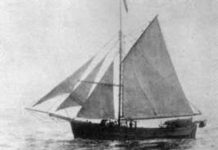Nestled against the lush green spaces of Mount Royal, McGill University is located in a bustling downtown section of Montreal. An historical symbol of advanced education in Lower Canada, the university produced prestigious graduates who went on to lead the country, changed medical science and introduced new avenues in physics. McGill University continues today, growing and adapting to encompass the progressive requirements of the future. The story of McGill University began with its namesake, politician and businessman James McGill. McGill bequeathed a portion of his wealth to the Royal Institute for the Advancement of Learning, to open an English college in Montreal.
Fur Trader and Merchant James McGill
Born in Glasgow, Scotland in 1744, McGill came to Canada in 1766 in the rush of the fur trade. For nine years, he took on the livelihood of the voyageur, “navigating the rivers and lakes of the Great Lakes frontier, over-wintering in unmapped wilderness and living off the land,” according to McGill University’s “Who was James McGill?” Prosperous, McGill firmly established himself as a businessman and merchant of fur, general goods and ammunition. Moving into politics after voluntary military militia duty, McGill became a Montreal city magistrate. Later, he was elected three times to the Legislative Assembly of Lower Canada. As a legislative member, he was able to support the establishment of the Royal Institute for the Advancement of Learning (RIAL).
Married to the widow Charlotte Trottier Desrivières in 1776, McGill enjoyed the role of stepfather to her children, and later revelled in being a grandfather. (He had no children of his own.) As other interests slowed, McGill moved into real estate, acquiring properties as compensation in a failed Detroit deal and purchasing many properties in Upper and Lower Canada. Lot parcels in Montreal, a farm in L’Assomption, a distillery and “Burnside, his summer home at the foot of Mount Royal,” were some of his acquisitions, noted J.I. Cooper in the “James McGill” entry of the Dictionary of Canadian Biography Online. In 1801, McGill “acquired 10,000 acres in Hunterstown Township and 32,400 acres in Stanbridge Township.”
Endowment for McGill College
On his unexpected death on December 19, 1813, James McGill’s will bequeathed his 46 acre Burnside property and £10,000 to the RIAL trustees, with the stipulation that the college or university included the name McGill. A charter to open the University of McGill College was granted in 1821 by King George IV, and the school opened for a small number of students in 1829. The opening was delayed for years due to opposition of McGill’s will by family members. Contesting the bequest, the matters were tangled in the courts for years, and finally settled in favour of the Royal Institute for Advanced Learning.
The McGill Faculty of Medicine opened in 1829, adopting the Montreal General Hospital’s Medical Institution, but it was not on campus. The first teaching facility built on the pastoral campus was the central and east wing of the Faculty of Arts building, constructed in 1843. “However, other than the Arts Building, the wooded campus remained a comparative wilderness,” said the McGill University, and the space was “nearly entirely untouched for another thirty years.” Meanwhile, the RIAL was amalgamated with McGill College in 1852, and geologist John William Dawson was appointed principal of the institution. As a teacher and strong promoter of public education, said Stanley B. Frost in The Canadian Encyclopedia, Dawson “formulated a scheme for affiliated schools and colleges across Canada which taught the McGill curriculum.” He also encouraged donations from wealthier supporters, since the college did not receive adequate public funding until a century later.
Faculties of McGill University
Construction got underway in earnest in 1880 with ten buildings erected over 27 years. The Faculty of Music was established in 1884, then serving women students only until 1904. Other faculties emerged over the decades: sciences – including chemistry and physics, economics, engineering, law, dentistry, religion, agriculture and environmental studies, management, arts, medicine and education. Today, the internationally-renowned university offers undergraduate, graduate and post-graduate degrees, with over 30,000 students enrolled each year.
Many names of McGill University graduates resonate in Canadian history – Prime Ministers Wilfred Laurier and John Abbott; basketball inventor James Naismith; Dr. Carrie Derick, botanist and McGill professor; and Dr. Gerald Bull, designer of “Project Babylon,” just to name a few. Recognized names also taught eager students at the university, three of many being physicist Dr. Ernest Rutherford, Canadian author and professor of Economics Stephen Leacock and Dr. Wilder Penfield, neurosurgeon and epilepsy specialist.
McGill University has earned an international reputation for excellence in innovative scientific research and scholarly achievements. There is no doubt that James McGill would agree his bequest has exceeded his greatest dreams for education in Lower Canada.
Sources:
- Cooper, J.I., “James McGill,” Dictionary of Canadian Biography Online
- “Who was James McGill,” McGill University
- Frost, Stanley B., “McGill University,” The Canadian Encyclopedia







